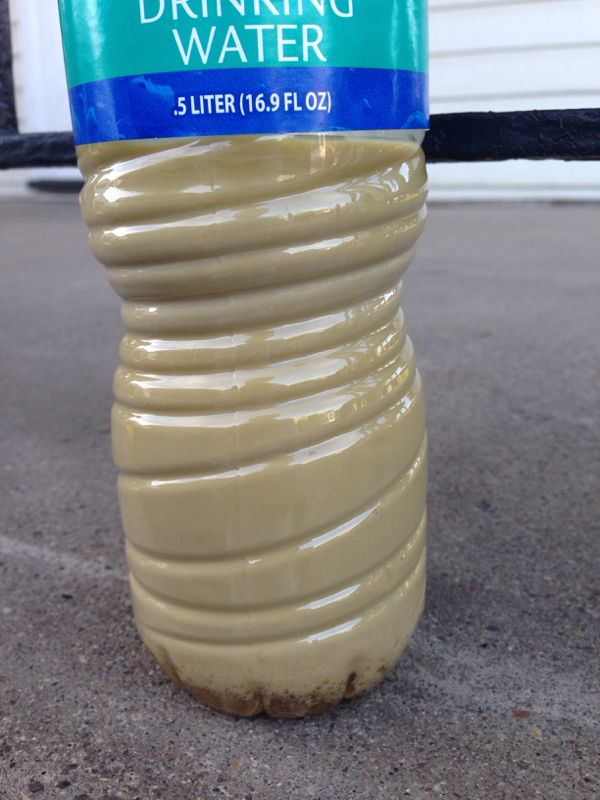Appreaciate the reply, and I have not had any Malibu's or Regals in to see. roadpie, are you tearing these actual engines down and examining like we are? What we are seeing has nothing to do with the oil squirters...they do an excellent job in cooling the pistons from the bottom side, and oil squirters are in millions of engines on the road for years w/no issues. Have you seen those intercoolers personally to verify no liquid in the intercoolers? I also agree with you that engine orientation should have no effect as well. This is why I am looking to discuss these failure with others that do work on them and if they actually are removing and draining the intercoolers. Most to date I have talked to never removed the intercooler, they just dropped engines out and replaced or replaced piston/rod assy.
What we are seeing EVERY case to date, is this liquid in the intercoolers, intake charge pipes, and pooled in the bottom of the intake manifolds:
No forged piston could compress this either...it is physically impossible. Only a very tiny amount of liquid can pass through the compression process, and this amount were draining from the intercoolers is extreme. We don't know if the regal is experiencing this yet as we don't get Buicks in here to see....but we do build a good number of Cadillacs, and this is what we are basing this on seeing it first hand (same with the Ford Ecoboost, and the only thing they share is a poorly and flawed PCV system design that allows this to build up in the crankcase and further in the intercooler):
NTSB safety agency to investigate Ford pickup engine trouble
NEW YORK TIMES NEWS SERVICE
Share0 Tweet0
0 Reddit0 0 Email0
The NTSB decided to investigate after receiving 95 complaints from F-150 owners saying they had experienced unexpected power loss during hard accelerations. The NTSB decided to investigate after receiving 95 complaints from F-150 owners saying they had experienced unexpected power loss during hard accelerations.
THE BLADE Enlarge | Buy This Photo
The National Highway Traffic Safety Administration said Sunday that it was investigating consumer complaints about “sharp reductions” in acceleration on 2011 to 2013 Ford F-150 pickups that are equipped with the 3.5-liter EcoBoost V-6 engine.
The action, called a preliminary evaluation, covers about 400,000 of the F-150 pickups, the safety agency said. A Ford spokesman, Michael Levine ,wrote in an email that although the number of vehicles affected was likely to be more than 325,000, the agency’s figure was too high.
The F-150 is one of the automaker’s most popular, lucrative and thus important vehicles. And the twin-turbocharged EcoBoost V-6 is one of Ford’s main engines, used to power not just the F-150 but also sport utility vehicles like the Explorer, crossovers like the Flex and cars such as the Taurus.
A Ford spokeswoman, Kelli Felker, wrote in an email that the company was aware of the investigation and will cooperate with the safety agency.
The safety agency decided to investigate after receiving 95 complaints from F-150 owners saying they had experienced unexpected power loss during hard accelerations. About one-third of those complaints said the problem had occurred in damp or rainy conditions. There were no reports of accidents.
“Attempting to pass a vehicle accelerating from 55 miles per hour and truck either stutters or stalls,” one owner wrote to the agency in February 2012. “This almost caused a head-on collision. I am scared to pull out in traffic or pass anyone.”
The safety agency said Ford had sent three technical service bulletins to dealers telling them how to cope with “intermittent/stumble misfire on acceleration” in humid or damp conditions.
The EcoBoost is a family of engines in various sizes. Ford has widely promoted the EcoBoost’s turbocharging and direct-injection technology as providing excellent power as well as fuel economy.
The investigation covers only the 3.5 liter V-6, which made its debut in the F-150 for the 2011 model year. In 2012, about 43 percent of the F-150s were equipped with the optional 3.5 liter engine, Levine wrote in an email.
If investigators find additional reason for concern during the preliminary evaluation, it would be upgraded to an engineering analysis.
A preliminary evaluation does not typically result in a recall. That outcome is more likely — but not certain — with an engineering analysis.
Last July, Ford recalled about 11,500 of its 2013 Escape crossovers because of a fire hazard with its 1.6 liter EcoBoost four-cylinder engine.
Read more at
http://www.ourtownperrysburg.com/Au...afety-agency-to-investigate-Ford-pickup-engine-trouble.html#HB4WT0sqsVQpz3It.99
Ford blamed it on "rainy conditions" which has turned out to be pure BS as it occurs in all climates.
Hydro lock is destructive in any internal combustion engine:
Hydrolock Explained
If an engine’s piston cannot complete its full travel cycle -- up to its minimum at the top of its stroke, then down to its maximum at the bottom of its stroke -- the engine cannot turn over. If the piston or pistons that cannot complete their travel cycle are prevented from doing so by a liquid above them, they slam to a halt on the upstroke, hence the “lock” in hydrolock. This condition occurs when fluid enters the top of the cylinder, rather than gas; gas is compressible and the piston can keep moving upward as it compresses, while fluid is not compressible and prevents the piston from reaching the top of its stroke. Water was called “hydro” in ancient Greek, hence the “hydro” in hydrolock.
Causes of Hydrolock
Outside water can enter the engine through the air intake if the vehicle is driven through a flood; vehicles designed with low-mounted air intakes can draw in water from a bow-wave caused by driving through relatively shallow standing water. Engine coolant can enter the cylinders when a head gasket blows. A failure in the carburetor or injector mechanisms can introduce liquid gasoline where only a vapor-air mixture should be.
Sponsored Links
Powerpoint Into Video
Download Videos To Your Desktop & Convert To Any Format - All Free!
www.videodownloadconverter.com
What Gets Damaged
Although an engine that hydrolocks at idle may simply stop, catastrophic engine failure is likely if an engine hydrolocks while running at speed. The most common result of hydrolock at speed is that the piston rods are deformed; they bend and fold between the piston at their top, which cannot travel upward any farther, and the crankshaft at their base, which continues to travel upward. Absorbing the force of the sudden stop may crack the block, crack the crankcase, destroy the head and shatter the bearings.
Manifestations and Rectification
Typically, an engine will seize solid if it hydrolocks at speed. If only one piston hydrolocks and the engine continues to move, there will be a loud screeching noise. Given that most of the major internal components have been destroyed, replacing the engine is typically more cost-effective than rebuilding.
If an engine hydrolocks at idle, it may simply stop and refuse to turn on the starter motor. There may well be no internal component damage. Rectification is by removing the spark plugs or injectors then turning the engine on the starter motor; this will expel the liquid from the cylinder or cylinders. Once reassembled, the engine should start as normal. The hydrolock, however, was a symptom, not a cause. If the liquid was introduced to the cylinder through a failed component, typically the head gasket, this must be diagnosed and rectified. Further, water is corrosive to the internals of an engine. If water has been inside a standing engine for any length of time, it could have caused rust bands to form inside the cylinder. These would have to be addressed, and the pistons perhaps replaced.
Read more :
http://www.ehow.com/info_12177155_gets-damaged-engine-hydrolock.html
So, since in every case to date this liquid mix has been present in the intercooler, charge pipes, and intake manifold (for the shops that have inspected them to see), there cannot be anything else causing these failures as we have yet to see detonation evidence on a single damaged piston, and the point of breakage on every one in the pictures here, that we have examined first hand, and the other dealer techs we have talked to are all breaking in the same areas....which is a sure indication of hydro-lock, especially when several have also had bent rods:
It takes allot of force to bend a rod....and if it was detonation we would be seeing erosion and pitting of the piston tops as is common with detonation.
Open for other ideas, but have been doing this for over 41 years, and see every type of engine failure possible and with some close study we can usually determine what caused a failure as the clues are usually right there.
Give me more of your thoughts on what else can be causing this. We boost the 3.6 DI engines to 500-600 HP and the pistons hold up fine until we exceed 600, and then the rods/rod bolts are what fails first. I really need more input from other tearing these down and make sure they are actually removing the intercoolers, or at least inspecting them internally with a boroscope.
Thanks!








